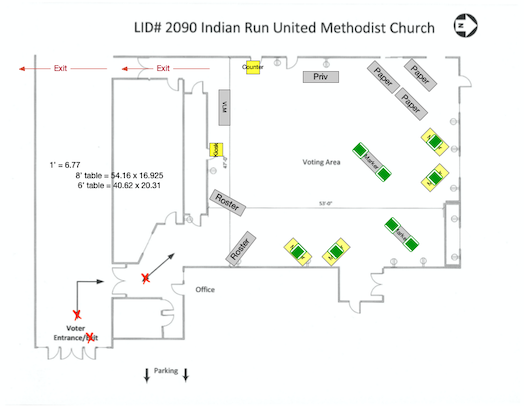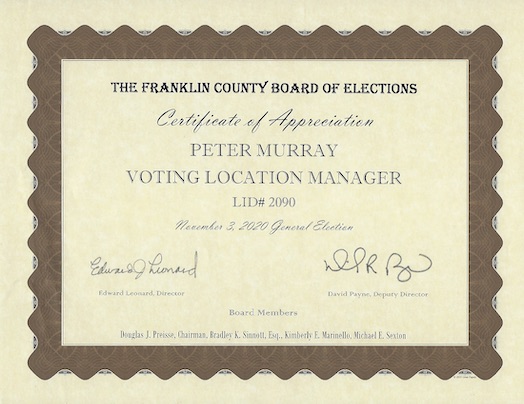As a Cog in the Election System: Reflections on My Role as a Precinct Election Official
I may nod off several times in composing this post the day after election day. Hopefully, in reading it, you won't. It is a story about one corner of democracy. It is a journal entry about how it felt to be a citizen doing what I could do to make other citizens' voices be heard. It needed to be written down before the memories and emotions are erased by time and naps.
Yesterday I was a precinct election officer (PEO—a poll worker) for Franklin County—home of Columbus, Ohio. It was my third election as a PEO. The first was last November, and the second was the election aborted by the onset of the coronavirus in March. (Not sure that second one counts.) It was my first as a Voting Location Manager (VLM), so I felt the stakes were high to get it right.
- Would there be protests at the polling location?
- Would I have to deal with people wearing candidate T-shirts and hats or not wearing masks?
- Would there be a crash of election observers, whether official (scrutinizing our every move) or unofficial (that I would have to remove)?
It turns out the answer to all three questions was "no"—and it was a fantastic day of civic engagement by PEOs and voters. There were well-engineered processes and policies, happy and patient enthusiasm, and good fortune along the way.
This story is going to turn out okay, but it could have been much worse.
Because of the complexity of the election day voting process, last year Franklin County started allowing PEOs to do some early setup on Monday evenings.
The early setup started at 6 o'clock.
I was so anxious to get it right that the day before I took the printout of the polling room dimensions from my VLM packet, scanned it into OmniGraffle on my computer, and designed a to-scale diagram of what I thought the best layout would be.
The real thing only vaguely looked like this, but it got us started.

We could set up tables, unpack equipment, hang signs, and other tasks that don't involve turning on machines or breaking open packets of ballots. One of the early setup tasks was updating the voters' roster on the electronic poll pads. As happened around the country, there was a lot of early voting activity in Franklin County, so the update file must have been massive. The electronic poll pads couldn't handle the update; they hung at step 8-of-9 for over an hour. I called the Board of Elections and got ahold of someone in the equipment warehouse. We tried some of the simple troubleshooting steps, and he gave me his cell phone number to call back if it wasn't resolved.
By 7:30, everything was done except for the poll pad updates, and the other PEOs were wandering around. I think it was 8 o'clock when I said everyone could go home while the two Voting Location Deputies and I tried to get the poll pads working. I called the equipment warehouse and we hung out on the phone for hours...retrying the updates based on the advice of the technicians called in to troubleshoot. I even "went rogue" towards the end. I searched the web for the messages on the screen to see if anyone else had seen the same problem with the poll pads. The electronic poll pad is an iPad with a single, dedicated application, so I even tried some iPad reset options to clear the device cache and perform a hard reboot. Nothing worked—still stuck at step 8-of-9. The election office people sent us home at 10 o'clock. Even on the way out the door, I tried a rogue option: I hooked a portable battery to one of the electronic polling pads to see if the update would complete overnight and be ready for us the next day. It didn't, and it wasn't.

Fortunately, the roster judges and one of the voting location deputies tore into the BUMPer Packet and got up to speed on how to use it. It is an old fashioned process: the voter states their name and address, the PEO compares that with the details on the paper ledger, and then asks the voter to sign beside their name. With an actual pen...old fashioned, right? The roster judges had the process down to a science. They kept the queue of verified voters full waiting to use the ballot marker machines. The roster judges were one of my highlights of the day.
And boy did the voters come. By the time our polling location opened at 6:30 in the morning, they were wrapped around two sides of the building. We were moving them quickly through the process: three roster tables for checking in, eight ballot-marking machines, and one ballot counter. At our peak capacity, I think we were doing 80 to 90 voters an hour. As good as we were doing, the line never seemed to end. The Franklin County Board of Elections received a grant to cover the costs of two greeters outside that helped keep the line orderly. They did their job with a welcoming smile, as did our inside greeter that offered masks and a squirt of hand sanitizer. Still, the voters kept back-filling that line, and we didn't see a break until 12:30.
The PEOs serving as machine judges were excellent. This was the first time that many voters had seen the new ballot equipment that Franklin County put in place last year. I like this new equipment: the ballot marker prints your choices on a card that it spits out. You can see and verify your choices on the card before you slide it into a separate ballot counter. That is reassuring for me, and I think for most voters, too. But it is new, and it takes a few extra moments to explain. The machine judges got the voters comfortable with the new process. And some of the best parts of the day were when they announced to the room that a first-time voter had just put their card into the ballot counter. We would all pause and cheer.
The third group of PEOs at our location were the paper table judges. They handle all of the exceptions.
- Someone wants to vote with a pre-printed paper ballot rather than using a machine? To the paper table!
- The roster shows that someone requested an absentee ballot? That voter needs to vote a "provisional" ballot that will be counted at the Board of Elections office if the absentee ballot isn't received in the mail. The paper table judges explain that with kindness and grace.
- In the wrong location? The paper table judges would find the correct place.
The two paper table PEOs clearly had experience helping voters with the nuances of election processes.
Rounding out the team were two voting location deputies (VLD). By law, a polling location can't have a VLD and a voting location manager (VLM) of the same political party. That is part of the checks and balances built into the system. One VLD had been a VLM at this location, and she had a wealth of history and wisdom about running a smooth polling location. For the other VLD, this was his first experience as a precinct election officer, and he jumped in with both feet to do the visible and not-so-visible things that made for a smooth operation. He reminded me a bit of myself a year ago. My first PEO position was as a voting location deputy last November. The pair handled a challenging curbside voter situation where it wasn't entirely clear if one of the voters in the car was sick. I'd be so lucky to work with them again.
The last two hours of the open polls yesterday were dreadfully dull. After the excitement of the morning, we may have averaged a voter every 10 minutes for those last two hours. Everyone was ready to pack it in early and go home. (Polls in Ohio close at 7:30, so counting the hour early for setup and the half an hour for tear down, this was going to be a 14 to 15 hour day.) Over the last hour, I gave the PEOs little tasks to do. At one point, I said they could collect the barcode scanners attached to the ballot markers. We weren't using them anyway because the electronic poll pads were not functional. Then, in stages (as it became evident that there was no final rush of voters), they could pack up one or two machines and put away tables. Our second to last voter was someone in medical scrubs that just got off their shift. I scared our last voter because she walked up to the roster table at 7:29:30. Thirty seconds later, I called out that the polls are closed (as I think a VLM is required to do), and she looked at me startled. (She got to vote, of course; that's the rule.) She was our last voter; 799 voters in our precinct that day.
Then our team packed everything up as efficiently as they had worked all day. We had put away the equipment and signs, done our final counts, closed out the ballot counter, and sealed the ballot bin. At 8:00, we were done and waving goodbye to our host facility's office manager. One of the VLD rode along with me to the board of elections to drop off the ballots, and she told me of a shortcut to get there. We were among the first reporting results for Franklin County. I was home again by a quarter of 10—exhausted but proud.
I'm so happy that I had something to do yesterday. After weeks of concern and anxiety for how the election was going to turn out, it was a welcome bit of activity to ensure the election was held safely and that voters got to have their say. It was certainly more productive than continually reloading news and election results pages. The anxiety of being put in charge of a polling location was set at ease, too. I'm proud of our polling place team and that the voters in our charge seemed pleased and confident about the process.
Maybe you will find inspiration here.
- If you voted, hopefully it felt good (whether or not the result turned out as you wanted).
- If you voted for the first time, congratulations and welcome to the club (be on the look-out for the next voting opportunity...likely in the spring).
- If being a poll worker sounded like fun, get in touch with your local board of elections (here is information about being a poll worker in Franklin County).
Democracy is participatory. You've got to tune in and show up to make it happen.
